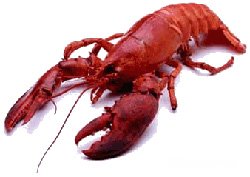Business idea - crayfish |
|
|
Feeding crayfishThe enemies of cancer in nature are the predatory fish (pike, perch, partly perch and catfish), wading birds, water rats and foxes. However, the river crayfish in the food chain are not only objects of a food for predatory animals, but they eat animal food: tiny snails, water worms, larvae of various insects, especially caddisflies, tadpoles and very rarely small fish. However, it is healthy fish have time to dodge that of the hunter. The food spectrum of river cancer varies depending on its age. Larvae, for example long cancer, eat up to 70-80% of animal food. Immediately after the transition to an independent way of life, fingerlings the length of 1,2-2 mm feed daphnias (59%), hironomids (25%). With the growth of the share of daphnia in the diet is reduced to 5%, at the age of two years daphnia not at all. Juveniles of all of different size groups consumes chironomids (24- 25%). The fingerlings in reaching the length of 2 cm start feeding on insects (18-45%) and their larvae, in particular, the caddisfly larvae, podenok, springes, etc. In process of growth of crayfish consumption increases shrimps, with 5% of the fingerlings, to 63% in the young of the length of 8-10 cm. Molluscs appear in the food fingerlings, when their length reaches up to 3 cm, and fish - with a length of fingerlings 4 cm. What to feed crayfish?River crayfish, especially their young, eat small invertebrates (daphnia, cyclops, rotifers, etc.), which, in turn, feed on small algae (phytoplankton). After fill the pond with water in it are gradually starting to develop certain forms of organisms: phytoplankton and minor forms of animal organisms living in the water column; benthos - animal organisms that are adapted to live on the ground, and zooplankton, which is kept in the water column. In other words, is formed by the water reservoir, which feed on the river crayfish. The more developed a natural food base of the pond, the more she can feed crayfish. The traditional way of increasing the natural prey of ponds is the application of mineral fertilizers and organic matter. Their application raises the natural productivity of fodder for about 2 t/ha. The optimal dose is considered to be the presence in water of 2 mg/liter of nitrogen and 0.5 mg/l of phosphorus. The uncontrolled application of fertilizers is not recommended. Mineral and organic fertilizers are applied in the bed of the pond in front of him filling of the rate of 50 kg of ammonium nitrate and 1 kg of superphosphate per 1 ha. The effectiveness of the fertilizer depends on the water temperature, Ph of water and soil, the technical condition of the water body. Ponds after filling with water, and before settling of crayfish should have the alkaline reaction (Ph 7-8,5).
The productivity of ponds for cultivation of cancers can be dramatically increase due to additional feeding them. Scatter food cancers should night, remembering that the cancer pet night. In those places, where the crayfish focus, scattered pieces of spoiled meat, fish, crop variety of vegetables, pieces of bread, various pickled cereals, chaff with involved in the water or debris oil production, etc. Carrion crayfish well eat, but that does not contaminate the feed pond, the better their place in the feeders. They have the form of boards with boards height of not more than 2 cm square. Feeders put down to the bottom and attached to the soil of any convenient way. The quantity of food for crayfish is not installed. In any case, it should not remain in the trough to the next feeding. In the transparent water of this set is not difficult, even at a considerable depth. However, if the water cloudy after the flood, or the rain, then the trough will have to take it out of the water, to be convinced of the necessity feeding. Remember that over feeding brings more trouble than the poor nourishment, in a pond with water plants. At the excess of subscribed feeds (when the food is not completely consumed) is its corruption, which can lead to deads. Feeding adult crabs is made only in the warm period of the year, as in winter, when they do not grow and does not fade, the food they need very little, and from the feed at this time only spoils the water. Feeding larvae of crabs in swimming pools and aquariums can be carried out almost the whole year, if the temperature of the water in them will not lower than 15 DEGREES. |
Developed: "Sitedesigners" |
The site is protected by the law on the protection of copyright, with the full or partial reprint of materials, active link to the source is obligatory! |



